A History of HMS SLINGER
|
 |
HMS SLINGER operating Seafires from 768 Deck landing
Training squadron in December 1944. |
H.M.S. Slinger was an 'Ruler' class escort carrier, her keel
was laid down on May 25th 1942 at Seattle-Tacoma Shipbuilding Co.
Tacoma, Washington, as a C3-S-A1 type freighter hull, Maritime
Commission hull number 243; Seattle-Tacoma hull number 27. Hull
number 27 was purchased by the US navy, to become the auxiliary
aircraft carrier USS CHATHAM AVG-32, however while still under
construction it was decided that AVG-32 was to be transferred to the
Admiralty on loan on her completion under the lend-lease agreement
that existed between the US and Britain.
She was launched on September 19th 1942 as ACV -32 and was assigned to
Willamette Iron & Steel shipyard in Portland, Oregon, for the completion
as an escort carrier. Her crew began to arrive in Portland during the
spring of 1943 and were under the charge of Lt. Cdr. W.H. Roberts, OBE,
the ship's Executive Officer.
While Slinger was in the hands of the Willamette Iron & Steel
yard there was a friendly rivalry between the workers and their opposite
numbers at other Portland ship yard working on ships for the Admiralty
and the Commercial Iron Works yard, where HMS Trumpeter was being
built. For many months the progress of both ships was proceeding at the
same pace until some key parts had to removed and sent to Bremerton Navy
Yard, Washington for adjustment. The parts had to be sent 200 miles by
road and who ever got the parts there first would gain valuable time
over their rival. The Willamette workers were first to deliver their
parts, but Commercial workers were not to be out done and increased
their productivity to make up the lost time; eventually Trumpeter
was completed first by one week.
CVE-32 sailed on her builder's sea trials at 08:00 on the morning of
Monday July 19th 1943. After passing down the Willamette River she
entered the Columbia River and trials began at 09:30. After testing her
anchors, steering, engines, and general handling she carried out a full
speed test and an emergency stop before completing a maximum speed run
over a measured mile, she returned to her berth at 16:00 after
completing the test schedule.
Transfer to RN and commissioning
On completion of defect rectification and final fitting out, CVE-32 was
transferred to the United Kingdom under Lend Lease and delivered on
August 11th 1943 at a ceremony held on the flight deck. The ship was
accepted on behalf of the US Navy by Captain L. D. Whitgrove USN, and
after the playing of the American national anthem he delivered her to
Captain A.N.C. Bingley O.B.E. RN who accepted her on behalf of the
Admiralty. Captain Bingley read out the order commissioning her as HMS
SLINGER (pennant number D26) and the White ensign and the Union Jack
were hoisted.
After the British national anthem had been played a short church service
was held during which Captain Bingley read a passage from the Bible
about David, the first 'Slinger' reading from a large print Bible that
had been donated to the ship by Mr. William Whitfield. The Portland
built ships and their crews had been warmly welcomed into the Portland
community and many individuals and organisations made donations of
recreation materials and equipment to the departing carriers that had
been built in their local ship yards.
The passage he read included Samuel 1, Ch17 verse 49 'And David put
his hand in his bag, and took thence a stone, and slang it, and smote
the Philistine in his forehead, that the stone sunk into his forehead;
and he fell upon his face to the earth.' which was the inspiration
behind the unofficial ship's badge.
Seattle: working up the ship
HMS Slinger left Portland on August 31st 1943 bound for Seattle
where she was to take on ammunition and stores, carry out gunnery
practice, and undergo a short work-up. Slinger exercised with her sister
CVE HMS Trumpeter which had sailed from Portland a week before
and was preparing to embark 848 naval air squadron on September 4th. The
squadron had formed in June at USNAS Quonset Point on the US east coast
with 12 Avengers, and had flown out to join the ship at Seattle to work
up the ship and the squadron in preparation for providing anti-submarine
patrols on the forthcoming Atlantic crossing to the UK. Part of
Slinger's work up period off Seattle included testing her flight
deck equipment, in particular the arrestor wires and her catapult, to
achieve this an Avenger from 848 squadron was utilised for a period of
practice deck landings.
|
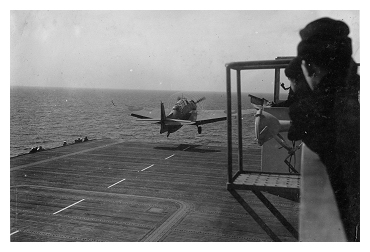 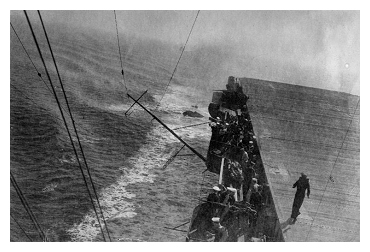 |
Left: Avenger, JZ102 attempting to recover flying speed
after an arrestor wire parted. Right: Unable to recover
the Avenger ditched off the starboard bow and was
overtaken by the ships. Photo: Courtesy of John Lawson |
The event proved to be an inauspicious start to Slinger's
operational service 'during one of the landings on September 15th the
arrestor wire parted as Avenger, JZ102 attempted to land. There was no
barrier rigged so the pilot, Lt P.F. McClintock, had to attempt to
recover flying speed as his aircraft continued on down the deck. Unable
to recover the Avenger ditched off the starboard bow and was overtaken
by the ship - Lt McClintock was recovered safely, however the severed
arrestor cable had whipped across the deck striking an Oerlikon Gunner,
Able Seaman Jack Hill, suffered serious head injuries and an almost
severed ear. Both the port and starboard catwalks were packed with
officers and men observing the trials but AB Hill was the only casualty.
Maiden voyage: Passage to Norfolk and Atlantic crossing
Her work-up and storing completed, HMS Slinger left Seattle in
company with Trumpeter and after clearing the Panama Canal on
September 29th, both vessels headed for the US Naval Operating Base at
Norfolk, Virginia, to collect consignments of aircraft for ferrying to
the UK. On her arrival at Norfolk Navy Yard on October 6th Slinger
was allocated to Western Approaches Command as a ferry carrier and began
embarking 54 airframes to be ferried to the UK. This load included the
10 Corsair IIs of No. 1830 Naval Air Squadron which were loaded on the
9th; 1830 had formed and worked up in the US at USNAS Quonset Point on
June 1st and was returning to the UK to continue training.
On completion of loading HMS Slinger departed Norfolk for New
York to join the next Liverpool bound convoy. Slinger and
Trumpeter sailed with convoy UT.4 from New York on the October
21st; when nearing Ireland on October 30th the two carriers detached
from the convoy and proceeded to Belfast where they unloaded their
squadrons to Royal Naval Aircraft Yard Belfast on November 1st.
Slinger then continued on to Greenock, Scotland to unload the
remainder of the aircraft and cargo.
In dock yard hands: Modifications in Chatham dock yard and repairs
after being mined
The ship was next ordered to proceed to Chatham Dockyard on November
20th where she was to be modified to meet RN standards and have
additional armament and communications equipment fitted. The
modification work was completed in early February 1944, and Slinger
was towed by tugs from Chatham to Sheerness on February 5th in
preparation for leaving the river Medway and proceeding to the Clyde the
next day.
Slinger weighed anchor at 0800 the following morning and
proceeded out into the channel, a gunnery test was carried out mid
morning during which time all of the ship's main armament was fired.
Around midday there was a loud explosion as the ship struck a mine; the
'flying bedstead' radar array collapsed onto the bridge while the HF/DF
mast toppled into the twin Bofors gun mounts, and the ship began to list
and drift as the engines stopped.
Slinger was eventually taken in tow by escorting destroyer HMS
Garth as she was drifting out of the swept channel and in danger of
entering our own mine fields. It was nightfall before the ship was taken
in tow by two tugs and began the journey back up the river Medway
towards to Sheerness, a journey that was to take all night. Water
continued to enter the ship and the onboard pumps could barely manage to
hold their own as she took on a dangerous list. At Sheerness, lighters
with electric pumps were secured alongside the ship and the long task of
pumping her out began. When the water was at last under control and the
list less pronounced Slinger was moved to Harland & Wolff's Royal
Albert dry dock for damage easement of her hull on the 12th. Her bottom
had been holed in two places, and her rudder and propeller had been
severely bent.
Slinger was to spend the next eight and a half months in the Port
of London and Woolwich docks under repair; during this time she was
partly cannibalised to complete the refits of several of her sister
CVEs, her forward lift for example was removed to repair HMS Stalker
in Match. Opportunity was also taken to upgrade the ship's defensive
armament fit. The Admiralty had decided to upgrade the single 20mm
Bofors units on all the CVEs of her class to twin 20mm Bofors in powered
mountings. During this time in the hands of the dockyard Captain Bingley
left the ship to take up a mew command, he was relived by Captain
Barrington Lungley Moore RN in June.
Work up and flying training
Repairs and modifications were completed by October 17th 1944 and
Slinger proceeded to the Clyde where she was transferred to control
of the Flag Officer Flying Training. The ship's flight deck equipment
was put through its paces by an Avenger from 778 service trials unit on
the 28th, this involved arrested landings and catapult assisted take
offs. On its final landing it experienced tail hook trouble and ended up
in the barrier.
|
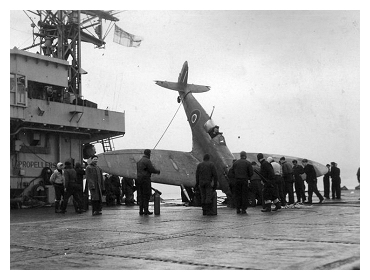 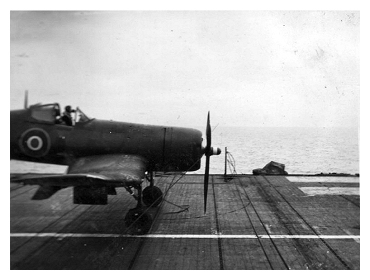 |
Left: A Seafire after entering the barrier on SLINGER
having missing all the arrestor wires during deck
landing training. Right: A Corsair caught at the moment
of entering the barrier on SLINGER having missing all
the arrestor wires during deck landing training. Photos:
Courtesy of David Yates |
From November 3rd 1944 Slinger was assigned to operate as a deck
landing training carrier for the next six weeks being visited by a
variety of aircraft belonging to 768 Deck landing Training squadron from
RNAS Abbotsinch. This period put the various ships' departments through
tier paces while training carrier pilots in the art of deck landing, and
was not without its mishaps. On the 23rd Seafire LR652, went over the
port side into sea, the pilot Midshipman R.J. Watson was rescued by
ML593 acting as Slinger's safety boat; two days later S/Lt E.O.
Atkin landed short in Seafire LR687 causing the aircrafts tail oleo to
hit the rounddown.
Passage to Ceylon
On December 19th 1944 No. 1845 Naval Air Squadron, equipped with 24
Corsair Mk. IVs, joined the ship from
RNAS Eglinton, and began deck landing
practice and exercising with the ship as it worked up in preparation for
deployment to join the British Pacific Fleet. 1845 was part of No. 10
Naval Fighter Wing with 1843 squadron, the latter was to deploy to the BPF aboard HMS Arbiter.
|
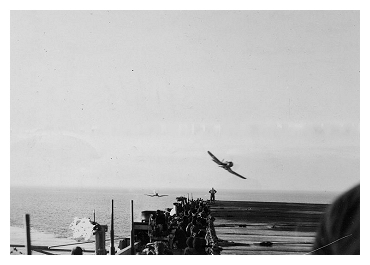 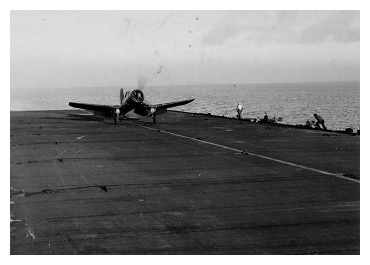 |
Left: Corsair's of 1845 squadron carry out a mock attack
before landing on SLINGER during working up. Right: A
Corsair of 1845 squadron landing on SLINGER as part of
the units workup before sailing for Australia. Photos:
Courtesy of John Lawson |
December was to be a period of intensive flying training for Slinger
and her new squadron and the strain began to show; The first accident happened three days later when Sub.-Lt Barlow failed to cut his throttle landing on in KD541 and entered the barrier. On the 27th Sub-Lt P.D. Bennett RNVR landed KD249 heavily on the rounddown and the undercarriage collapsed. In the New Year Midshipman E.F.K. Webb RNVR ended in the barrier in KD465 on January 4th. Tragedy struck later that same day when Corsair KD546, flown by Sub-Lt G.A. Anderson RCN, dropped its port wing on landing and swung to port collapsing the undercarriage leg, the aircraft came to rest on the DLCO (Deck Landing Control Officer) platform killing the DLCO Sub-Lt F.E. Ure RNVR. There was one final incident before the work up period ended, KD27 crashed on landing on the 8th, pilot unknown.
On January 11th 1945 Slinger and CVEs Khedive and
Speaker together with a destroyer escort of Volage, Venus,
Eskimo, Wolverine and Whitehall sailed from the Clyde bound
for Gibraltar on the first leg of the voyage to join the BPF in
Australia, under command of Captain B. L. Moore, (Speaker) Senior
Officer. The group of ships called at Gibraltar on the 16th, then set
course for Malta. The next day both Speaker and Slinger flew off
aircraft armed with rocket projectiles to search for a U-boat reported
off the North African coast. The small convoy entered Valletta Harbour
on the 19th before arriving at Alexandria on January 22nd, entering the
Suez Canal on the 24th for transit to the Red Sea. After a brief stop at
Aden to refuel and store ship on January 28th the convoy steamed
straight across the Indian Ocean to Ceylon, arriving at Colombo on
February 4th.
Passage to Australia
Flying training and exercising with the ship had continued throughout the voyage with only one aircraft incident recorded; on January 21st Sub.-Lt .C. Leddy RNVR made a heavy landing in KD563 resulting in severe fuselage structure strain, the aircraft was written off.
The three CVEs were to Part Company; on arrival at Ceylon, Speaker and
Slinger sailed for Sydney on the 6th, Khedive remained in Ceylon to join the East Indies fleet. On February 8th the traditional 'crossing the line' ceremony was observed aboard
Speaker and Slinger which had crossed the equator at 21:00 hours the day before; the festivities took up most of the day. On February 11th both ships were called to assist in a search for survivors from a torpedoed American troop ship, the S.S. Peter Silvester, 1000 miles off the coast of Western Australia.
|
 |
HMS Speaker in company with Slinger on passage to
Sydney. Photo: Courtesy of David Yates |
The aircraft of 1830 and 1845 squadrons conducted aerial searches but
after five days no trace was found and Speaker continued on to
Sydney leaving the area late on the 16th, Slinger remained to
continue searching until the 19th before she had to break off and
proceed to Sydney. On arrival off Sydney on February 25th 1845 squadron
flew off all serviceable aircraft to RNAS Schofields (Mobile
Naval Air Base No.3). New South Wales; three unserviceable
airframes, which had suffered damage during the search on the 14th and
15th, were off loaded and taken by road to RNAS Bankstown (Mobile
Naval Air Base No.2), the ship was secured alongside at Circular
Quay in Sydney on the 28th.
Operations with the Air Train
Work began to prepare the ship to join the 30th Aircraft Carrier
Squadron (30 ACS; at that time comprising the CVEs Chaser, Ruler,
Speaker, Striker and Slinger under the command of Commodore
Carne in Striker), her pennant number was changed to R313 for
operations in the Pacific theatre. She was to be employed as a forward
area replenishment carrier and would only carry replenishment loads of
spare airframes for issue to other carriers whilst at sea as a part of
the Air Train, the aviation logistic support element of the British
pacific Fleet's logistics life-line 'the Fleet Train'. This was a
collection of merchant and military vessels which supplied the fleet
with fuel, food, armaments and other stores. Based in Sydney, with
forward bases at Manus in the Admiralty Islands and Leyte in the
Philippines, the Fleet Train operated over a distance of some 2,500
miles each way.
On March 1st the ship's company set about painting the ship, applying
her new Pacific camouflage scheme and new pennant number, work also
commenced loading stores. The following day Admiral Sir Bruce Fraser,
the C-in-C, visited the ship and gave a pep talk to the crew about the
importance of the work of the Air Train. Slinger was to be
employed as a forward area replenishment carrier, operating as part of
Task Force 112. To carry out this task the ship was loaded with a
replenishment load of 25 airframes, made up of 10 Corsairs, 7 Hellcats,
3 Seafires, 1 Avenger and 4 Fireflies for issue to the fleet during
replenishment periods; this load was to be carried in addition to her
squadron.
Operations: march 10th - April 18th
Once loading was completed Slinger sailed for Manus in the
Admiralty Islands on the morning of March 11th; 1845 squadron
re-embarked later that morning. On arrival at Manus on the 17th Slinger joined the ships of TG 112, the first forward area
replenishment group which was assembled in the deep water anchorage of
Seadler Harbour. A number of the ship's officers went ashore to the
newly opened Royal Naval Air Station on Ponam Island, HMS Nabaron,
a short distance up the coast. This proved to be a reunion with their
old CO, Captain Bingley who was now in command of the Forward Area MONAB
(Mobile Naval Air Base No.4) which occupied and operated the former
US navy air strip on the island.
The first elements of the logistic support group, Task Unit 112.2.1
consisted of the escort carrier Striker (Commodore 30th ACS),
escorted by Crane, the Findhorn and Whirlwind. And
Task Unit 112.2.5, consisted of the oilers San Adolpho, San Ambrosio
and Cedardale, with Speaker --for CAP duties- escorted by
Pheasant and Kempenfelt left Manus on March 18th and would be
in position to replenish the elements of the British Pacific Fleet, Task
Force 57, when they prepared to begin Operation 'Iceberg'.
|
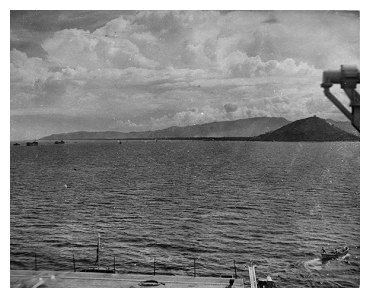 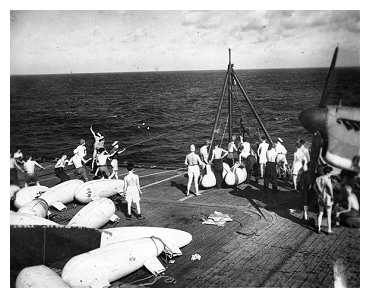 |
Left: HMS SLINGER anchored in San Pedro Bay, Leyte Gulf.
Right: Loading spare drop tanks while anchored in San
Pedro Bay, Leyte Gulf. Photos: Courtesy of David Yates |
Slinger was appointed as convoy leader of the second convoy of
logistic support ships, comprising of Lothian (flag ship
Rear-Admiral, Fleet Train), Empire Spearhead, Artifex, Bacchus, Wave
King, Wave Monarch, Arndale, Dingledale, Fort Colville, Aase Maersk,
Denbighshire, Robert Maersk, Thyra S., Hermelin, and Tyne,
which left Manus on March 19th bound for the Philippines. The convoy
arrived at Leyte Gulf on the 26th and anchored in San Pedro Bay.
After refuelling and restoring, the Logistic Support Group Task Unit
112.2.3, including Slinger, left Leyte on March 29th to proceed
to the replenishment area east of Luzon, a rectangular area which
covered e 5000 square miles of ocean. At this time there were three CVEs
in the Logistic Support Group, Speaker provided Combat Air
patrols (CAP) for the Fleet Train while Striker and Slinger
provided replacement aircraft and aircrews.
Between the 2nd and the 5th of April, Task Force 57 took on fuel and
stores from the vessels of the fleet train. Slinger issued 22
replacement aircraft to the fleet carriers and recovered 2 'flyable
duds' 'non-flyable duds were ditched overboard from the fleet carriers
after their engines, and any salvageable equipment had been removed as
there was no means to transfer them to the replenishment carriers whilst
at sea. Demand for replacement Corsairs and aircrew was so high that
1845 squadron was disbanded on the 5th, her aircraft and aircrew were
dispersed to HM Ships Formidable and Victorious.
|
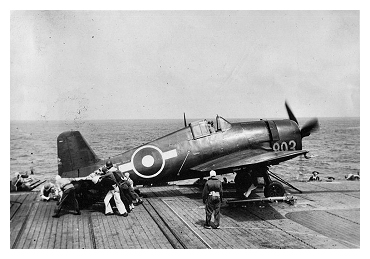 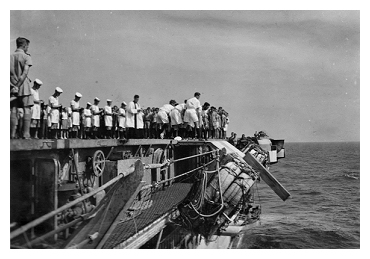 |
Left: A replacement Hellcat is readied for take off,
part of SLINGER's replenishment load for issue to the
fleet carriers of the BPF during a period of
replenishment and refuelling. Photo: Courtesy of John
Lawson Right: The burial at sea of Petty Officer
Mitchell one of the casualties transferred from HMS
INDEFATIGABLE, he died on board SLINGER on April 6th
1945 as the ship departed the refuelling area to return
to Leyte. Photo: Courtesy of David Yates |
Later on the 5th casualties were embarked for transport to the Hospital
ship Oxfordshire at Leyte; these were ferried across by jackstay
transfer. 16 men came from HMS Indefatigable which had received a
direct hit by a Kamikaze aircraft several days before. It struck the
flight deck adjacent to the island, destroying the flight deck sick bay,
killing 14 and wounding 16. Slinger withdrew from the
replenishment area on the 6th after receiving further casualties from
Illustrious, Indomitable, and Victorious and headed back to
Leyte; a burial at sea took place later that day for Petty Officer
Mitchell, one the casualties taken off Indefatigable, who died of
his injuries. Slinger also suffered a casualty from amongst her
own crew on the 6th when 19 year old Able Seaman David Lias RNVR, was
discovered to be missing; he presumably fell overboard and drowned.
Operations: April 19th - May 27th
Slinger reached Leyte on April 8th and transferred the wounded to
HMHS Oxfordshire, she sailed the next day for Manus to
receive another replenishment load. During the passage to Manus, fate
dealt Slinger another blow when increasing to maximum speed she began to
shake from stem to stern, these strong vibrations subsided when her
speed was reduced to 12 knots.
Slinger had been struck by the bane of the 'Bogue class' CVE's:
her LP rotor, part of the reduction gearing that harnessed the steam
turbines to the propeller shaft, had begun shedding teeth. Slinger
was unlucky in that she (and Trumpeter) did not have this
problem rectified before leaving the US, the modifications for RN
service being carried out in the UK. The other vessels in her class were
modified in Vancouver ad their LP rotors were checked and corrected
while in the dockyard. The reduction in speed meant that Slinger
had to drop out of the convoy and make her way towards Manus
independently.
It was decided after radio messages were exchanged with RAFT and C-in-C
BPF that Slinger should proceed back through the Islands at best
speed to Brisbane to under go repairs in the newly opened Cairncross Dry
Dock, another unfortunate `First' - the first carrier ever to use it,
just as she had been the first carrier in London. Slinger arived
at Brisbane on April 19th but was unable to enter the dry dock until the
28th. The huge gear wheel that formed the LP rotor had to be taken out
through the hangar deck and when examined it was found that many teeth
had been damaged and these had to reshaped on a lathe to make all the
teeth of a uniform size, about two-thirds of their original width. The
repairs were to take four weeks, during which time VE Day was celebrated
on May 8th.
Upon putting back to sea on May 27th one side effect of the repair
became apparent, Slimier could now only achieve a maximum speed
of 12 knots and therefore could no longer conduct flying operations; as
a result she was reallocated to the role of Ferry Carrier, transporting
replacement aircraft from Australia to Manus and the Philippines. This
change in role saw Slinger effectively become an auxiliary vessel,
accordingly her pennant number was again changed, this time to A452.
|
 |
HMS Slinger at anchor in Sydney July 1945 wearing her
auxiliary pennant number A452. Photo: Courtesy of David
Yates |
Ferry operations: May 29th 'August 20th
On arrival in Sydney on the 29th work began on loading stores and
embarking passengers in preparation for a round trip to Brisbane
departing on June 3rd and arriving Brisbane on the 5th. After unloading
the ship sailed for Sydney later that day on the return leg, during this
passage very high seas and squalls were experienced adding a day to the
voyage. On June 8th Slinger sailed into Sydney and after passing
under the great bridge moored at Pyrmont in readiness to embark her
first ferry load.
At the beginning of July there was another change of commanding officer,
Captain Moore leaving to take up the post of Senior British Naval
Liaison Officer, Philippine. He was replaced as CO by the ship's
executive officer Commander JG Hopkins RN, an ex-submariner he had
joined Slinger in February. Slinger's new role also saw a
reduction in the size of the ship's company, a much smaller crew was now
required so many men were drafted to the RN Barracks, HMS Golden Hind
in Sydney.
|
  |
Two views of HMS SLINGER loaded with a mixed bag of
airframes, including Corsairs Barracudas and Avengers in
Brisbane for transport to Manus. Photos: Courtesy of
John Lawson |
Slinger next sailed as a ferry carrier bound for Manus and the
Philippines carrying spare airframes as part of the build-up for the
anticipated invasion of Japan now that Okinawa had been taken. At the
beginning of August the ship was moored in Seadler Harbour when the news
of the first atomic bomb being dropped on Hiroshima came over the radio.
During this period the ship carried at least one cargo that comprised of
120 airframes.
Round trip to Hong Kong: September - October 1945
After VJ Day (August 15th) Slinger was recalled to Australia to
join the humanitarian relief efforts that were to commence with the
liberation of territories formerly held by the Japanese. On August 17th
Slinger anchored of Ponam Island and loaded a cargo of damaged
aircraft for transport to
T.A.M.Y. I (HMS Nabsford, Archerfield, Brisbane), and sailed for
Australia. After unloading in Brisbane she proceeded to Sydney where she
arrived at the end of the month to begin outfitting as a makeshift troop
transport. Her hanger was to become a vast dormitory outfitted with
tiers of bunks, and spaces previously used by the air engineering
department were put to use.
On September 5th the advance party of
HMS Nabcatcher (Mobile Naval Air Base No.8) embarked. HMS Slinger
sailed for Hong Kong on the 9th carrying men, food and medical supplies
for the relief of the colony. On route she called at Brisbane to take on
more stores and Mindanao Bay in the Philippines to refuel.
|
 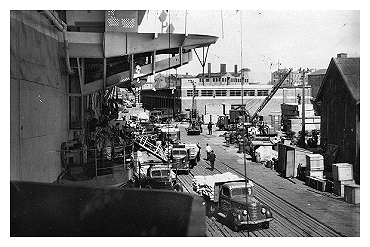 |
Left: Personnel of MONAB 8 parade on the flight deck of
HMS Slinger leaving Sydney for Hong Kong, note the small
number of Barracuda aircraft ranged aft. Photo: Courtesy
of E.C. McCarthy. Right: HMS Slinger alongside in
Hong Kong unloading food and medical supplies for the
colony. Photo: Courtesy of E.C. McCarthy |
In early October the ship arrived in Hong Kong and work began unloading
stores in Kowloon; the work was undertaken by former Japanese Naval
personnel who proved to be very efficient at the task. Japanese
prisoners were employed extensively in the colony in the early months
after the surrender, working parties marching to and from assignments
were a common sight. After only a few days alongside work had to be
suspended as Slinger and the vessels of the BPF in Hong Kong were
ordered out to sea to ride out a typhoon which was fast approaching the
colony. A small working party remained ashore at Kai Tak airfield which
was being reopened by
MONAB 8, which was where much of the offloaded stores were being
taken. The ships of the BPF spent five days at sea riding the typhoon
before it was safe to re-enter Hong Kong. Work resumed unloading the
remaining stores and the embarkation of the civilian prisoners of war
from the Stanley Road Prison Camp began.
The passengers were civil servants, shipping company officials,
servicemen and their families. also embarked were three prisoners under
guard; these men, Major Boon, the Camp Commandant, an elderly Army
Lieutenant anda Sergeant, had been accused by their fellow prisoners of
collaborating with the Japanese and were to face court martial
proceeding back in Britain. The prisoners were under the charge of Lt.
Hughes, the ship's gunnery officer; he was also given custody of
documents about the Camp and photographs of the Japanese camp personnel
which were to be delivered to Naval Intelligence.
Upon her arrival back in Sydney Slinger came alongside the wharf
at Pyrmont, in Sydney Docks; large crowds met the ship, many were there
to meet family members and loved ones. Major Boon and his fellow
prisoners were transferred to the cruiser HMS Devonshire to be
taken home for trial. Slinger then sailed for her last round trip
to the Admiralty Islands, via Brisbane, on arrival she lay off the reef
at Ponam Island to load vehicles and equipment from MONAB 4 for ferrying
to Australia. Slinger arrived back in Sydney in early November.
|
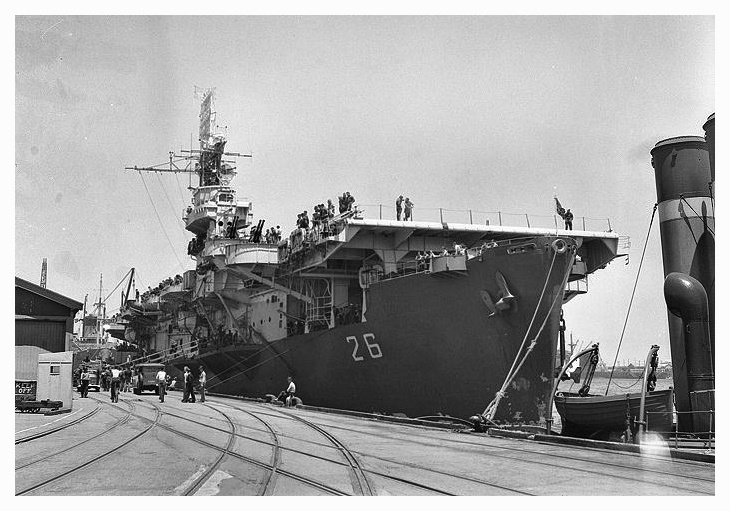 |
HMS Slinger alongside in Sydney shortly before sailing
for the UK in November 1945 'note she has reverted to
her original pennant number of 26. Photo: Courtesy of
Mike Roshier |
Passage to the UK: November 10th 'December 27th
Slinger moved to a mooring alongside at Sirius Cove, where she
began loading passengers and stores. The bulk of her passengers were
personnel of MONAB 4 who began embarking on November 5th. There was also
a contingent of female nursing staff taking passage to the UK. Major
Boon also arrived back on board, having been transferred back to
Slinger after a spell in hospital in Sydney; Devonshire had
already sailed for the UK as planned without him.
All loading completed, HMS Slinger slipped her moorings in Sirius
Cove, Sydney, at 11:00 hours on the morning of Saturday November 10th
1945, bound for Fremantle. From there she made for Colombo to embark
more passengers before making for the Suez Canal. The ship briefly
called into Gibraltar before beginning the final leg of the journey,
local leave was granted and the captain and navigator went ashore. While
anchored in Gibraltar Roads a storm front developed, the wind soon
increased to gale force and began to act on the ship causing her to drag
her anchor and there was a danger that she would crash into the North
Mole. The weather was too severe for the captain and other officers to
return to the ship by boat, so the officer of the watch decided to take
the initiative and called for the engine room to get the ship underway.
Having checked the ship's drift the anchor was secured and Slinger
put to sea to weather the gale. The Captain and liberty men were
re-embarked once the storm had abated.
The foul weather continued to dog Slinger, all the way across the
Bay of Biscay and up the English Channel, as she made port at Portsmouth
on December 22nd. After unloading some of her passengers, cargo and mail
from the Far East she sailed for Plymouth. The sea was so rough on the
afternoon of Christmas Eve when Slinger arrived off Plymouth
sound she could not pass the breakwater, instead she anchored in Cawsand
Bay until the weather eased sufficiently to allow her to secure
alongside at No 5 Jetty, Devonport naval dockyard on December 27th.
Major Boon was put ashore later that day, handed into the custody of an
armed escort for transportation to Exeter prison to await trial.
Decommissioning and return to US Custody: December 29th 0 February
27th
Once all the passengers had departed from the ship, leave was granted
while work began removing certain items of Admiralty equipment from the
ship; she was no longer required for service in the RN and was to be
paid off and returned under the terms of the Lend-lease agreement. On
January 16th 1946 Slinger left Devonport for the Clyde to be
de-stored in preparation for her decommissioning. On the 25th she left
the Clyde for the last time and proceeded to Norfolk, Virginia.
CVE '32 was returned to U.S. Navy custody on February 27th 1946 at
Norfolk Navy Yard. She was stricken for disposal on April 12th 1946 and
put up for sale. She was sold into mercantile service on November 21st
1946 when she was purchased by the Robin Line (part of the Seas Shipping
Co., Inc., of New York); on completion of her conversion into a
passenger freighter she was renamed 'Robin Mowbray'. She operated on the
company's weekly New York to South and East Africa run until she was
sold for scrap and was broken up in Taiwan starting on January 29th
1970.
Content revised:
31 October 2021
Sources used in compiling this account:
Click here for a list of
Primary sources
Additional sources:
Fold3.com various documents including;
Admiralty War Diaries
US Naval Station, Seattle, Washington
US Naval Station, Manchester, Washington
Puget Sound Navy Yard War Diaries
US Thirteenth Naval District War Diaries
Norfolk Navy Yard War Diaries
Mew York Navy Yard War Diaries
Miscellaneous documents
|
Home
page |
go to the top
|
Comments (5)
My wife's father was the AB Jack Hill mentioned under Seattle: Working up the ship.
"Asbury" refers to HMS Asbury (later known as HMS Saker 11) which was a shore based transit accommodation for the Royal Navy located just outside New York City and used by crews picking up ships allocated to the Royal Navy under the provisions of Lend-Lease from the USA. He would have been on board for the handover ceremony at Portland, Oregon on 11/08/1943 and when the ship hit a mine in 1944. He was transferred to HMS STRIKER in June 1944, at the same time Capt Bingley left.
Any idea what a Greaser did on board?
On STRIKER he became a Donkeyman - what did they do?